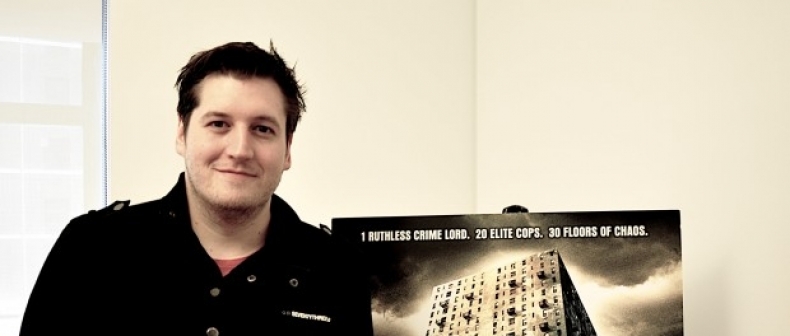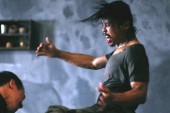
You may not have heard of The Raid yet, but it’s about to become a cult classic. The film was the breakout hit of The Toronto Film Festival’s Midnight Madness program this year and is one of the most unrelenting and thrilling action movies in recent memory. The Indonesian fist-mashing epic is about a team of police officers who are sent into a derelict high-rise run by a crime lord, only to be caught almost immediately and targeted by the entire population of the building. It’s a darkly tense and claustrophobic ride in the style of Assault On Precinct 13 with masterfully choreographed martial arts sequences thrown in to up the ante for the popcorn-munchers in the audience. If you’re a fan of action films, The Raid offers blood-soaked bliss and not a second of screentime is wasted.
Surprisingly, the movie comes from British director Gareth Evans who has been working in the Indonesian film industry for a few years, having previously earned international attention with Merantau. The Raid brought Evans to new levels of acclaim and success, with the film already locked in for a Hollywood remake and the director himself currently preparing to helm the sequel before the original even hits the screens. The Toronto Standard got a chance to speak with the burgeoning master action orchestrator about the origins of his new film, his unexpected path to an international directing career, and his plans for the future.
How did you end up directing films in Indonesia? I’m assuming from your accent that you’re not originally from there.
[Laughs] No, I’m not quite a local yet. I lived in the UK for most of my life. I left when I was 27. I always wanted to work in the film industry, but I never really did anything of note in the British film industry. I didn’t push enough. I kept myself to localized in Wales. My wife is Indonesian and Japanese and she put in a few calls for me from Britain and got me a directing job. I worked on a documentary about Silat, a style of martial arts from there. I’d always been a fan of martial arts films and I knew all about kung-fu and a few other styles, but I’d never heard of Silat before. So the process of shooting that documentary became something like six months of research. I learned about the culture and the martial arts discipline and then I also met Iko Uwais [the star of Merantau and The Raid]. So that whole process was kind of like gradually be given new core elements that I could use to make films. It was an opportunity that I couldn’t pass up.
Are you fluent in the language then?
I’m not quite fluent yet, but I’ve got a better understanding of it now than I ever did before. Iko taught me some good stuff that I could use in terms of directing and then he also taught me a lot of bad things. So, I know I can direct actors and I know I can insult someone’s mother now.
Could you talk a little bit about your relationship with Iko? He’s become a key collaborator for you as both an actor and as a fight choreographer.
Well, I always thought that if I got the chance to show off Silat, it could become the new discipline for action movies. And with Iko, we found the perfect person to demonstrate what Silat can do and what it could be. To me, it’s a fascinating juxtaposition between movements that have a certain grace and beauty to them, but then contrasted with a very corrosive violent attack. So that’s what I really like about Silat and what I think is fresh and new about it. The way Iko moves and the way we design choreography together, it’s almost as if he knows exactly how each movement will look on camera. It’s rare to find that kind of understanding in someone on an immediate level. We both get this kick when we do the choreography, no pun intended by the way, from coming up with ideas and trying to figure out what we can do that will look unique and different. There are moments when we become like teenage boys giggling about the fact that we’ve come up with a cool new move where somebody gets slammed into a wall. It’s just so much fun to work on these films with him. My job is to go to the office with two who are at the top of their game in terms of martial arts and use them like my action figures. I can slam them into each other and play fight with them for days on end while designing these action sequences. Its really so much fun.
Was it difficult to choreograph the action scenes in such confined spaces for The Raid?
Yeah, it does provide a challenge, but it’s a good challenge to have. Sometimes it’s actually harder when you are designing a fight in a wide open space with lots of people. Because then you have too many things that you can do. It’s like a blank canvas and it can be tough to fill. Whereas if it’s a confined space, you know you’ve got walls, you know you’ve got a phone nearby and a light fixture nearby. So there are all these different things you have to make use of. It also just feels more immediate, there’s more of an urgency to the fight scene as well. For some reason as an audience, we respond more to a confined space than a wide open space. You feel like there’s more opportunities to be trapped and lose forward momentum and there’s a lot of drama to create out of that.
Did you have any specific action movie influences in mind when you sat down to write the script?
Yeah, when we were coming up with concept big influences were things like Die Hard, the original Assault On Precinct 13, Escape From New York, and The Warriors. These are all classic examples of the genre where all the action surrounds one location and event. It was important to me to have that influence to figure out how to structure the film and know where to go from one set piece to the next. So Die Hard we borrowed from in terms of how far we would take it in terms of making a spectacle out of the film. And then Assault On Precinct 13 informed us in terms of how to achieve a feeling of claustrophobia and that feeling of being constantly surrounded without showing the people all of the time. We didn’t have the budget to have extras all over the place in the building, so a lot of that came out to what John Carpenter did in Assault On Precinct 13 and his visual design. My favorite part in that film is when the lights go out and then they start getting shot at by snipers and all you see is the broken glass and the people being shot at. You never actually see who is outside, they’re all in the shadows. You get an idea that they probably didn’t have the budget for extras and neither did we. So we had to do something similar when we designed the film and rely on sound design to fill in the blanks and fill in the narrative space to give the impression that these guys are constantly under fire.
I read that you’d actually planned on making a larger scale film before The Raid and this concept came out of the budgetary limitations. So I was wondering what that initial idea was and if you still plan to make it?
Yeah that was a standalone movie that kind of fell apart. The Raid became a Plan B movie that we could make fairly easily on a lower budget. While we were developing The Raid, the initial project called Berandal [an Indonesian slang term for “thug”] ended up becoming part of the franchise. So Berandal‘s going to be a sequel to The Raid now. We had done so much design work and fight choreography before that fell apart. We were ready to go. The script was ready, we just needed the financing. So when we had to do The Raid instead, I never wanted to completely abandon those ideas and that project. As a result of that, I was looking into ways to connect the two and the only problem that I ever had with Berandal was that I was never really happy with the lead character and his motivation for what he was doing. Once I realized that if I made that movie a continuation of The Raid and made that character the cop, it made much more sense and solved all of those problems. So now it’s a sequel to The Raid and thanks to the screenings we’ve had at film festivals and the response on a sales level, we’re finally in a position where we can make that film with the budget we needed. So we’re going to start shooting that in January next year.
And what about The Raid remake that’s been announced? Will you be involved with that?
A bit. Screen Gems bought it. I’m going to be an executive producer and Iko and his team are going to help with the choreography, so that’s kind of exciting. There are a few things that I really wanted to do in my version, but couldn’t because of the budget limitations. So hopefully they’ll get a chance to try some of that. I’m kind of excited to see what someone with a fresh pair of eyes can do with it and it helped us get the sequel made, so no complaints.
Do you think you’ll continue to work in the Indonesian film industry since you’ve had such good luck and success there or would you like to go back to Britain or even try your luck in Hollywood?
I feel like Indonesia gave me my career to be honest, so I plan on always trying to continue to work here. The sequel to The Raid will definitely be shot here and in Indonesian. But, I do also want to try and do some things outside of Indonesia. I definitely want to try and make a film in the US or the UK. But, I have to be sure that project is the right one for me. I don’t want to just sign on to some franchise and end up being a director who doesn’t get to have the same control and identity that I want to have in my films. So, I’m a bit cautious at the moment about what film I do outside of Indonesia. It has to be the right project for me. My ideal plan is to make the sequel next, do something in America or the UK, and then go back to Indonesia and do another film there. I would love to just bounce back and forth from country to country and project to project.
_____
Phil Brown writes about classic films for Toronto Standard‘s Essential Cinema column.
For more, follow us on Twitter at @TorontoStandard and subscribe to our newsletter.












